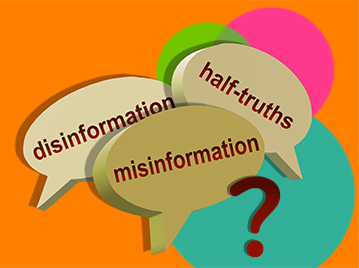Misinformation: Navigating the Web of Deception in the Digital Age
Introduction
In the age of information, the internet has become a powerful tool for sharing knowledge and connecting people. However, it has also given rise to an alarming phenomenon: misinformation. Misinformation refers to false or misleading information that spreads rapidly, often causing confusion and harm. In this blog, we delve into the pervasive issue of misinformation, exploring its impact, underlying causes, and the importance of critical thinking in navigating the digital landscape.
Understanding Misinformation
Misinformation is the unintentional or deliberate dissemination of false or misleading information. It can take various forms, including rumors, fake news, hoaxes, and conspiracy theories. With the advent of social media and instant communication, misinformation can spread like wildfire, reaching millions in a matter of seconds.

Impact of Misinformation
Misinformation can have significant and wide-ranging consequences:
Public Health: Misinformation about health issues can lead to dangerous practices, vaccine hesitancy, and the spread of preventable diseases.
Social Unrest: Misinformation can fuel social divisions, exacerbating conflicts and sowing discord in communities.
Elections and Democracy: Misleading information during elections can influence voters and undermine the democratic process.
Environmental Awareness: False narratives can hinder efforts to address climate change and environmental conservation.
Causes of Misinformation
Several factors contribute to the spread of misinformation:
Confirmation Bias: People may share information that aligns with their pre-existing beliefs, regardless of its accuracy.
Echo Chambers: Online platforms can create echo chambers, reinforcing and amplifying misinformation within like-minded groups.
Lack of Fact-Checking: Rapid sharing of information without verification perpetuates the spread of falsehoods.
Malicious Intent: Some individuals or groups deliberately spread misinformation to manipulate public opinion or advance their agenda.
Combating Misinformation
Addressing misinformation requires a multi-faceted approach:
Media Literacy: Promoting media literacy and critical thinking empowers individuals to discern reliable sources from misinformation.
Fact-Checking: Encouraging fact-checking by reputable organizations helps counter the spread of false information.
Platform Responsibility: Social media platforms can implement measures to reduce the spread of misinformation and promote reliable sources.
Transparency: Encouraging transparency from news outlets and social media platforms about their content policies and algorithms.
The Role of Individuals
Each individual plays a critical role in combating misinformation:
Verify Before Sharing: Verify information from credible sources before sharing it with others.
Diversify Sources: Consume information from multiple sources to gain a well-rounded perspective.
Be Mindful of Emotions: Be aware of emotional reactions to information, as it can influence the perception of accuracy.
Promote Critical Thinking: Encourage critical thinking and open discussions about the information encountered online.
Conclusion
Misinformation is a formidable challenge in the digital age, posing threats to public health, democracy, and societal harmony. As we navigate the vast ocean of information online, let us be vigilant, discerning, and responsible consumers. By promoting media literacy, fact-checking, and critical thinking, we can build a society that values accuracy, truth, and informed decision-making. Together, we can combat the web of deception and cultivate a digital landscape where reliable information prevails, empowering us to make well-informed choices and fostering a world where knowledge is a beacon of light in the sea of information. As we journey through the complexities of misinformation, let us remember that our collective efforts, both as individuals and as a global community, hold the key to a more informed, connected, and enlightened world.

Comments
Post a Comment